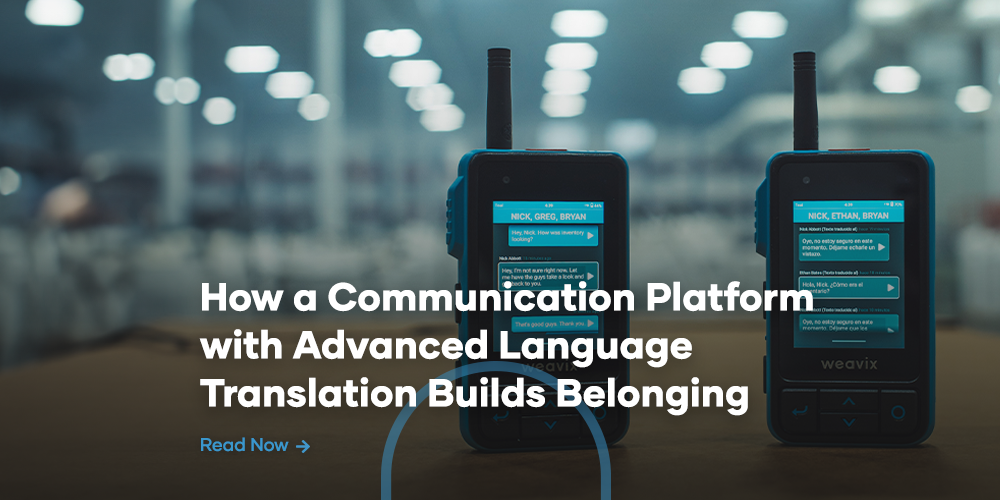Nearly all industries with a large population of frontline workers have one thing in common: they all experience challenges with their frontline communications. Food and beverage manufacturing is no exception.
Employing over 1.7 million people in the US and contributing over $1.2 trillion to its GDP, food and beverage manufacturers' work affects everyone. However, poor frontline communication keeps them from operating at their best and supporting the enterprise’s overall success and business continuity.
It’s important for business leaders to understand and find solutions to the communication issues in food and beverage manufacturing. Oftentimes, they are the leading cause of more serious problems, like a spike in safety incidents, reduced productivity, quality issues, and lower profits.
Issue #1: Cultural and Language Barriers
Food and beverage manufacturers produce, package, and transport cuisine from many different cultures all over the world. In doing so, it’s no surprise that their workforces are as diverse as the foods they produce.
Cultural and language differences directly impact frontline workers and the effectiveness of which they can work as a team, regardless of the industry they’re in. Language barriers create confusion among workers, make it difficult to collaborate on projects and tasks, and alienate those who don’t speak the predominant language in the workplace.
At the organizational level, the negative implications of language barriers are more drastic. Enterprises that take a strong and direct approach to overcoming cultural differences in their workforce often experience lower turnover rates and increased productivity on the production floor.
So, what are they doing to get these results?
Industry leaders are investing in new technologies to help their frontline workforce overcome language barriers and work together more effectively. A communication platform for frontline workers with language translation capabilities allows workers to stay connected without the added challenges that arise when language barriers are left unresolved.
Issue #2: Noisy Work Environments
Food processing facilities, manufacturing and packaging plants, and even the land where food is harvested are not your typical work environments. The heavy machinery, constant influx of people, and production clatter make for a noisy workplace – it’s no surprise that ear protective equipment is a common sight.
Noise is not a communication issue that we can get rid of for the sake of improving frontline communication. But that doesn’t stop food and beverage manufacturers from working around it to find new communication solutions for their workforce.
Instead of fully relying on voice and face-to-face communication, many facilities have opted for more visual communication to overcome noisy workplaces. This ranges from digital signage on the production floor to text-based and dictation-enabled communication through the walt® smart radio.
While enterprises haven’t been able to rid their frontline work environments of noise, utilizing more visually-centric communications with the available technologies provides a solution.
Issue #3: Quickly Communicating Possible Contaminations & Other Food Safety Breaches
Food safety is important to supporting communities, supplying people with quality products, and maintaining customer’s trust in your brand. So, if there’s ever a food emergency that can affect those groups, such as a contaminated product, workers must be able to communicate that effectively and escalate it to the right people before the situation gets worse.
Frontline workers have the potential to act as the enterprise’s first line of defense against any threat to food safety. The problem keeping enterprises from empowering their workforce to take a more direct approach persists because of the lack of available communication technology to connect every worker.
When fully enabled, frontline workers can ensure the proper protocols are followed to keep emergencies from happening, respond quickly once informed of a situation, and minimize its impact on business continuity. To reach this optimal level, frontline workers must be connected to their peers, teams, and supervisors.
weavix® utilizes its smart radio, mobile app, and website console to remove silos, make everyone accessible, and allow for immediate response. Whether they work on the frontline, in another building, or at the company headquarters, our platform unifies communication to help food manufacturers minimize and remedy any potential safety risks in production at scale.
Issue #4: Limited Device & Coverage Capabilities
Radios have been the standard communication device for frontline workers since their inception. Recently, industry leaders have debated switching over to phones instead of radios for frontline communication, with some raising concerns over the privacy, usability, and security of phones in a frontline setting.
However, many people, including workers, project managers, and site supervisors, are not on board with using phones as their workforce’s main source of frontline communication. Yet, traditional radios aren’t cost-effective for a typical budget and haven’t expanded their offerings much past push-to-talk and texting.
Many food and beverage manufacturers feel restricted in what devices are available for their frontline workers to use that:
- won’t sacrifice the security and integrity of the enterprise,
- can fully function in a frontline work environment, and
- provide essential communication capabilities to best enable their frontline workers.
To meet the rising demand for new and affordable communication solutions for frontline workers, food and beverage manufacturers continue to use weavix® for secure and reliable communication. As a platform with a radio device and mobile app, workers can communicate with voice, images, and video, known as Push-to-Three or PT3, from anywhere in the facility.
Issue #5: Dropping Engagement Levels in Food & Beverage Manufacturing
Poor frontline communication has a major impact on engagement levels, work ethic, and overall productivity. Your frontline workforce is a valuable resource; one you shouldn’t take for granted. But, when workers don’t have a way to communicate, it’s difficult for them to receive recognition for their hard work, understand or connect with the bigger picture, and feel like a valuable part of the enterprise.
Opening lines of communication allows your workers to bring the value they produce to the forefront. With weavix®, every worker is supplied a walt® smart radio, so everyone is easily accessible to receive critical information and work as a team. Now, workers can connect more effectively with their peers and forge meaningful relationships.
When workers are more engaged and actively participating in discussions with their peers and leadership, it’s easier to develop an emotional investment in their organization. They have a better understanding of why their role is important and the impact they have in the bigger picture. They aren’t just producing food, they’re supporting entire communities.
How Food and Beverage Manufacturers Can Resolve Communication Issues
Resolving frontline communication issues is more unique than if you were in traditional work settings. There are many additional barriers and complexities that those in an office setting don’t often experience, let alone becoming the norm.
Food and beverage manufacturers have taken big strides to resolve the communication issues impacting their frontline workforce. One such effort has been investing in a frontline communication solution to encourage engagement and help them overcome the barriers they face.
Most industries, especially those with a large frontline population, fall victim to poor frontline communication. Using weavix® to help their workforce communicate freely, food and beverage manufacturers oftentimes experience a rise in both engagement and productivity on the frontline.
Schedule a demo to see how weavix® can help resolve communication issues affecting your frontline workforce today.
Subscribe
Don’t miss out on industry news and information. Subscribe to interweave, the official weavix™ blog today.




